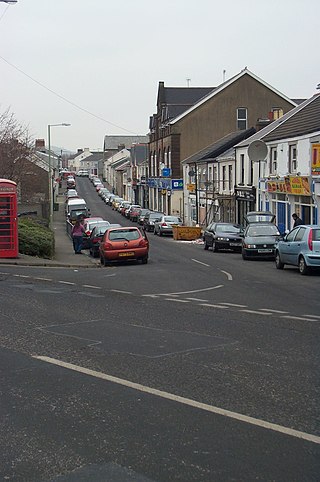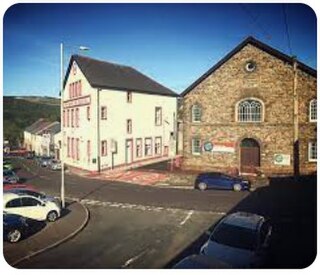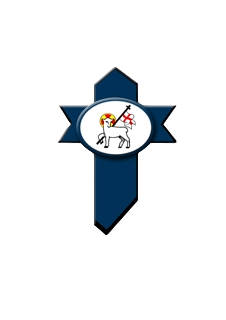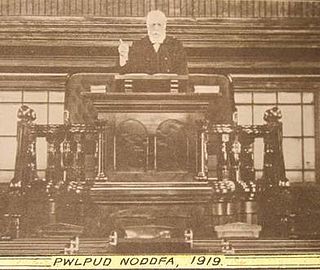
St John the Baptist's is an ancient parish church in the centre of the town of Aberdare, Wales.

St John the Baptist's is an ancient parish church in the centre of the town of Aberdare, Wales.
The original parish church was built in 1189. Some of its original architecture is still intact.
John Wesley preached on two occasions at St John's in 1749. [1]
By the first half of the nineteenth century, St Johns's could only accommodate 250 people although the parish of Aberdare had a population of 13,000. [2] The condition of the church was said to be poor, and one commentator stated that the parishioners worshipped their maker in darkness. [3] By 1853, the burial ground was full and the vicar, John Griffith, reported that until the ground was drained last year there was so much water in the soil that the coffins were often floating in it. The drainage now is not very complete. [4] It took Griffith ten years to instigate the restoration of the church at a cost of £900, and it only became suitable for regular worship once again shortly before his departure to be rector of Merthyr Tydfil. [5] In the meantime, Griffith had instigated the building of St Elvan's Church, commonly known as the Cathedral of the Valleys, within sight of the older building.
The building is Grade II* listed. [6]

Aberdare is a town in the Cynon Valley area of Rhondda Cynon Taf, Wales, at the confluence of the Rivers Dare (Dâr) and Cynon. Aberdare has a population of 39,550. Aberdare is 4 miles (6 km) south-west of Merthyr Tydfil, 20 miles (32 km) north-west of Cardiff and 22 miles (35 km) east-north-east of Swansea. During the 19th century it became a thriving industrial settlement, which was also notable for the vitality of its cultural life and as an important publishing centre.

Hirwaun is a village and community at the north end of the Cynon Valley in the County Borough of Rhondda Cynon Taf, South Wales. It is 4 miles (6 km) NW of the town of Aberdare, and comes under the Aberdare post town. At the 2001 census, Hirwaun had a population of 4,851. increasing at the 2011 census to 4,990. The village is on the Heads of the Valleys Road and at the southern edge of the Brecon Beacons National Park.

Abernant is a small village north-east of the town of Aberdare, Rhondda Cynon Taf, Wales. Like many in the South Wales Valleys, it was once a coal-mining village.

Aberaman is a village near Aberdare in the county borough of Rhondda Cynon Taf, south Wales. It was heavily dependent on the coal industry and the population, as a result, grew rapidly in the late nineteenth century. Most of the industry has now disappeared and a substantial proportion of the working population travel to work in Cardiff and the M4 corridor. Many residents also work in the nearby towns of Aberdare and Pontypridd.

Trecynon is a village near Aberdare situated in the Cynon Valley, in Rhondda Cynon Taf, Wales. It dates from the early nineteenth century and developed as a result of the opening of the Aberdare Ironworks at Llwydcoed in 1800.

Llwydcoed is a small village and community north of the Cwm Cynon, near the town of Aberdare, Rhondda Cynon Taf, Wales, with a population of 1,302 as of 2011 census.

St. John Baptist Church in Wales High School is a church secondary school located in Aberdare, Wales. The school serves children from all over Rhondda Cynon Taf and surrounding counties. It opened in 1975.
Llanvabon is an area and former parish in South Wales. As described in 1849, it comprised two hamlets, in the union of Merthyr Tydfil, hundred of Caerphilly, county of Glamorgan, 9 miles from Merthyr Tydfil; containing 1449 inhabitants. A Topographical Dictionary of Wales (1849) described it as follows:
This parish is bounded on the west by the river Tâf, and on the east by the Romney; and comprises about 5000 acres, of which 1120 are arable, 2230 pasture, 1000 common, 500 woodland consisting chiefly of oak, and the remainder roads and water. The surface is in general mountainous; and the scenery picturesque, especially in the vicinity of the village of Craigyberthlwyd, from which the views are striking and beautiful. The soil comprehends gravel, clay, and peat, and the chief agricultural produce is wheat, barley, and oats, the last of which is grown in a larger quantity than either of the two former. Tiles for building are made, and there are excellent stone-quarries, and coal-mines, but they are not in operation to any great extent, the latter being chiefly on the border, and appropriated to the use of the neighbourhood only.
The greater part of the colliers of Gellygaer, an adjoining parish, live in Llanvabon. The ancient seat of the Lanbradach family is situated here; and besides the village above-named, the parish contains those of Quakers'-Yard and Nelson.
It is intersected by the road from Cardiff to Merthyr, which passes about two miles and a half westward from the church; and by the Glamorganshire canal, on the banks of which, within its limits, is situated the Navigation-House, where this important line of communication is joined by the Aberdare Canal, and where barges are loaded with coal and iron for the port of Cardiff. The TâfVale railway, also, passes by Quakers'-Yard and the Navigation-House, and is joined in this vicinity by the Aberdare railway, for the construction of which an act was obtained in 1846.
The living is consolidated with the vicarage of Eglwysilan: the tithes have been commuted for £270, of which a sum of £200 is payable to the Dean and Chapter of Llandaf, and £70 to the vicar. The church, dedicated to St. Mabon, is an ancient structure, consisting of a nave and chancel, forty-three feet in length and twentyone in breadth, and containing accommodation for about 120 persons. There are two places of worship for Calvinistic Methodists, two for Independents, and one for Baptists; in each of which a Sunday school is also held. James Thomas, in 1730, gave by will a rent-charge of £2 for the benefit of the poor, to be equally divided between those of each hamlet.

Thomas Price was a leading figure in the political and religious life of Victorian Wales, and the central figure of the Cynon Valley for more than forty years.

Calfaria Baptist Chapel, Aberdare, was one of the largest baptist churches in the South Wales Valleys and the oldest in the Aberdare valley. The chapel had an ornate interior, including a boarded ceiling with a deeply undercut rose, while the balcony balustrading had a cast iron front with an intricate foliage design. These features were common in the Welsh chapels of the late nineteenth century. The organ was installed in 1903 at a cost of £850. It was played for the last time in 2012 by Robert Nicholls, during a Radio Cymru broadcast shortly before the closure of the chapel.
John Griffith was among the most prominent clergymen in industrial south Wales during the second half of the nineteenth century. He was rector of Aberdare from 1846 until 1859. From 1859 until his death in 1885 he was vicar of Merthyr Tydfil where he proved a strong supporter of workers' rights and, by the end of his life a supporter of the disestablishment of the Church of England in Wales. This reflected the way in which he gradually abandoned the strong Tory principles that he espoused at the beginning of his career at Aberdare. He died on 24 April 1885.
Aberdare Local Board of Health was established in 1854 in response to the 1848 Public Health Act, and a report on the sanitary condition of the town conducted by Thomas Webster Rammell. It was eventually replaced in 1894 by Aberdare Urban District Council.

Noddfa or Noddfa Welsh Baptist Chapel, was located in Treorchy in the Rhondda Valley. It was one of the largest Baptist churches in the South Wales valleys, and one of the largest and grandest of all Welsh chapels.

Ebenezer, Trecynon was an Independent (Congregationalist) chapel in Ebenezer Street, Trecynon, Aberdare, Wales. It was one of the earliest Independent chapels in the Cynon Valley and remained an active place of worship until 2009.

Ramoth, Hirwaun originally a Baptist chapel in Davies Row, Hirwaun, Aberdare, Wales. Services at Ramoth were held in the Welsh language. Following renovation in 1982, the building continues to be used for Christian worship as an Assemblies of God fellowship.

St Fagan's Church is a Grade II-listed Anglican church in the village of Trecynon near Aberdare, Rhondda Cynon Taf, Wales. It was originally built in the mid-nineteenth century in the Gothic Revival style, but burned down a few years later and was rebuilt.

Llantrisant Church is located in Llantrisant, Rhondda Cynon Taf, Glamorgan, Wales. Built within a short distance of Llantrisant Castle, it was originally in the Norman style of architecture. When described in History of Llantrisant, Glamorganshire (1898), little of the original church remained, with the only traces of Norman architecture being the baptismal font, a portion of the south door, and the lower part of the western arch of the nave. The tower, which is about 70 feet (21 m) high, contains a peal of six bells. The living is a vicarage. Llantrisant Church is a Grade II* listed building.

Hen-Dy-Cwrdd is a disused Unitarian chapel in Trecynon, Aberdare, Wales. Services at the chapel were conducted in the Welsh language.

St Elvan's Church is a Grade II* listed Anglican church in the centre of the town of Aberdare. It was built in 1851–1852, largely at the instigation of John Griffith, vicar of Aberdare from 1847 until 1859.
Rhos, Mountain Ash was a Baptist chapel in Mountain Ash, Glamorgan, Wales. Services at Rhos were conducted in the Welsh language.